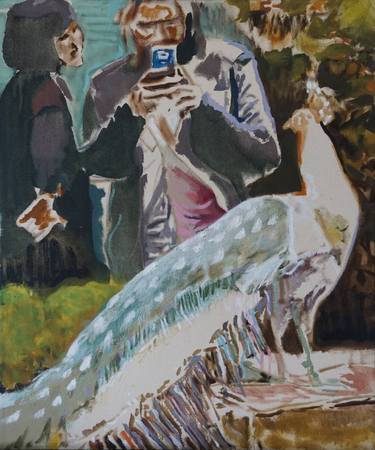The Evolution of Art: A Comprehensive Overview to Figurative Oil Painting
The Evolution of Art: A Comprehensive Overview to Figurative Oil Painting
Blog Article
The Role of Feeling and Expression in Figurative Oil Paint: An In-Depth Analysis of Topic Issue and Composition
The interplay of feeling and expression in figurative oil painting serves as an essential lens through which one can examine the elaborate relationship in between subject matter and make-up. Artists harness various techniques, from color choice to brushstroke dynamics, to cultivate emotional vibration within their jobs.
Recognizing Feeling in Art
Emotion in art acts as a powerful conduit for expression, enabling musicians to convey complex feelings through their work. In figurative oil paint, this emotional deepness is typically portrayed via the depiction of the human figure, catching the nuances of human experience. The option of topic, color combination, and brushwork all contribute to the psychological resonance of an item.
Artists frequently bring into play individual experiences, societal concerns, or universal motifs to evoke sensations in the customer. For circumstances, a picture might show susceptability, while a vibrant figure in motion can signify freedom or turmoil. These emotional strings link the viewer to the art work, promoting a discussion that transcends the visual tool.
In addition, the interplay in between light and shadow can magnify psychological strength, leading the viewer's look and accentuating particular aspects within the structure. Using structure in oil paint better adds layers of complexity, welcoming a tactile action that enhances the psychological experience. Overall, comprehending feeling in art is critical for valuing the subtleties that define metaphorical oil painting, as it changes simple depiction right into a profound exploration of the human condition.
Crucial Element of Structure
In the world of metaphorical oil painting, the make-up functions as the underlying framework that arranges visual components and improves the emotional narrative. Necessary parts of structure include equilibrium, contrast, prime focus, and rhythm, each adding to the total influence of the artwork.
Balance refers to the distribution of visual weight within the paint, which can be achieved with asymmetrical or symmetrical plans. A healthy structure supplies stability, allowing the viewer to engage with the item sympathetically - figurative oil painting. Comparison, on the other hand, entails juxtaposing different components, such as light and dark or cozy and awesome colors, to lead the viewer's eye and stimulate psychological reactions
The focal factor is critical, as it routes attention to the most significant component of the paint, usually highlighting the psychological core of the story. By masterfully incorporating these crucial elements, musicians can craft compelling and mentally powerful metaphorical oil paintings that captivate and involve their audience.
Subject and Its Impact
Subject issue plays a critical role in figurative oil paint, as it not only functions as the structure for the narrative but additionally forms the audience's analysis and psychological interaction with the artwork. The option of subject-- be it a singular figure, a group dynamic, or a thematic representation-- directly affects the psychological ambience conveyed to the target market.

For circumstances, portraits usually evoke personal connections, disclosing the intricacies of human expression and personality, while scenes illustrating common tasks can develop a feeling of belonging or fond memories. In addition, the social and historical context of the topic improves the customer's understanding, motivating deeper representations on social norms, worths, and the human condition.
Various subject matters also produce varying degrees of interaction; a significant conflict shown via figures in stress might generate feelings of anxiousness or compassion, while calm landscapes can conjure up serenity and consideration. Eventually, the effect of subject matter in metaphorical oil paint is extensive, as it functions as her explanation an avenue for emotional vibration, leading the customer's action and interpretation, and fostering a link in between the viewer and the artwork. This interaction is essential for the effective communication of the musician's intent.
Methods for Evoking Sensations
The effectiveness of metaphorical oil paint in sharing feelings is dramatically affected by the methods utilized by the musician. One of one of the most essential methods is making use of shade theory, where the tactical choice of shades can evoke certain emotional actions. Cozy colors, such as oranges and reds, often elicit feelings of enthusiasm or hostility, while cooler tones like blues and eco-friendlies often tend to evoke peace or sadness.
An additional vital technique is the manipulation of light and shadow, called chiaroscuro. This method improves the three-dimensionality of numbers, creating remarkable contrasts that can Visit This Link intensify psychological deepness. The placement of light can direct visitors' feelings, highlighting certain elements of the make-up.
Brushwork also plays a critical function; loose, expressive strokes can convey power and spontaneity, whereas smoother methods might suggest serenity or precision. Moreover, the arrangement of subjects within the make-up can affect psychological influence. Close closeness can recommend affection, while distance might show isolation.
Inevitably, the combination of these methods allows musicians to craft stories that resonate with the audience, transforming a simple aesthetic experience right into an important link expressive emotional trip. - figurative oil painting

Case Researches of Notable Functions
Checking out remarkable works of metaphorical oil paint discloses exactly how various techniques are used to evoke effective emotions. One excellent instance is Edvard Munch's "The Scream," where the altered number and swirling history convey existential fear. Munch's use of color-- brilliant oranges and deep blues-- magnifies the emotional influence, showcasing how palette choices can shape visitor experience.
An additional significant job is Pablo Picasso's "Les Demoiselles d'Avignon." Here, fragmented forms and bold brushstrokes mirror a tumultuous psychological landscape, testing traditional representations of the female number. Picasso's ingenious make-up not just records the customer's interest however also invites consideration on motifs of identity and sexuality.
In Addition, Frida Kahlo's "The 2 Fridas" supplies an emotional expedition of duality and self-identity. The contrasting figures, connected by a common heart, exemplify Kahlo's emotional deepness and individual narrative. figurative oil painting. Her meticulous focus to information and symbolic aspects serve to involve customers on a visceral level
These instance research studies underscore the extensive link between feeling and structure in figurative oil paint, exposing how musicians harness method to interact complicated feelings and stories that resonate throughout time and culture.

Final Thought
In final thought, the interaction of emotion and expression in metaphorical oil painting substantially enhances the customer's experience and analysis of the artwork. With a mindful choice of subject issue and compositional techniques, artists share profound narratives that reverberate on both global and individual levels. The application of color brushwork, theory, and chiaroscuro further enhances psychological deepness, transforming each canvas into an effective representation of the complexities of the human experience.
In figurative oil paint, this psychological deepness is typically represented via the depiction of the human figure, recording the subtleties of human experience.Additionally, the interaction in between light and darkness can enhance emotional strength, directing the visitor's gaze and drawing attention to specific aspects within the structure. The usage of appearance in oil paint further adds layers of complexity, inviting a tactile reaction that enhances the emotional experience.The focal point is important, as it guides focus to the most substantial component of the paint, usually highlighting the psychological core of the story. Inevitably, the influence of subject issue in metaphorical oil painting is profound, as it serves as a conduit for emotional vibration, leading the visitor's feedback and analysis, and promoting a connection between the artwork and the observer.
Report this page